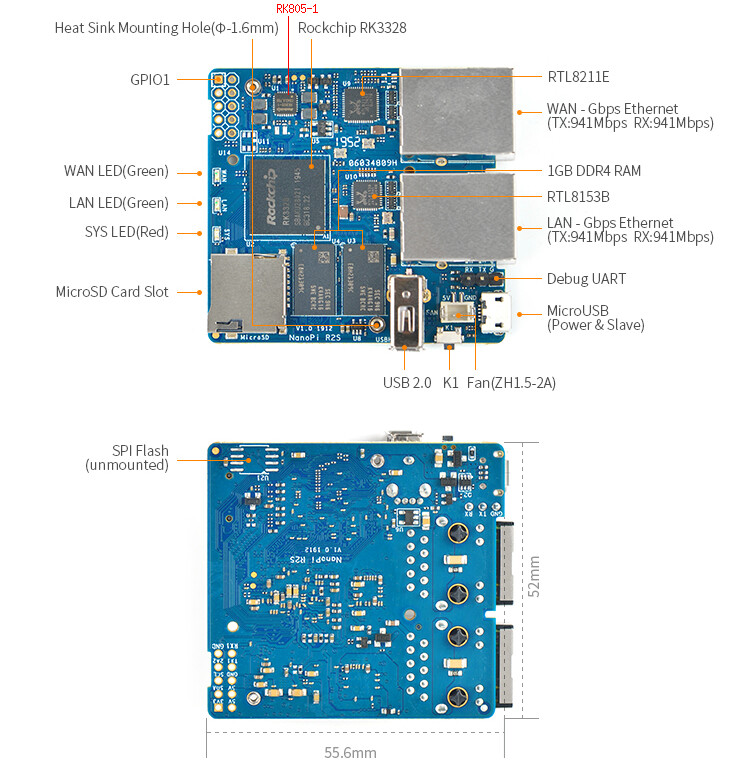NanoPi R2S

Backgroud
I was fascinated with soft routers for a long time, but because of the existence of Netgear R7800, I did not start with soft routers.
Netgear’s R7800 is very powerful. Since its release in 2016, it is still the only WIFI5 (802.11ac) router in the world that supports two 2x2 MU-MIMO devices.
Why not say WIFI6? Because the official standard of WIFI6 has not been released to date, the current WIFI6 routers are all gimmicks from manufacturers.
R7800 was finally taken away by others on February 2, 2020.
Then I started to transform the home network. I ordered a small speaker (wdr7650) from TPLink and set up a mesh network with wired backhaul. The effect was very good.
With the AP, let’s start looking for a soft router. So began to browse the forum, Google various materials.
Fancy “J1900”, low power consumption, good performance, can run full Gigabit bandwidth, and rich firmware, such as Linux / openwrt / ddwrt / EdgeOS / RouterOS / Aikuai / Gaoke. However, the merchant was unable to ship the product, so this plan was eventually abandoned.
The second-hand solution, Raspberry PI 4B, has USB 3.0 and a real Gigabit Ethernet port. The software resources are also rich. The main reason is that the home has PI 2B and is familiar with it. But the merchant was unable to ship, so it was abandoned.
I saw a merchant pushing the NanoPi R2S at the Enshan Forum. I checked the information and found that it is small in size and low in power consumption, and comes with two Gigabit network ports, one real Gigabit network port and one converted from USB 3.0. The speed can reach Gigabit bandwidth. So I decided to buy it.

The R2S was received On February 22, 2020. It is very small and uses a 5V 2A power supply.
Install ROM
It’s very simple. Just like Raspbian, download the ROM directly and write it to the SD card. The capacity of the SD card must be greater than 4G.
- Here we use the official firmware FriendlyWRT, which is the customized openwrt by the manufacturer, and the download address is as follows:
- 189-Cloud,Access code:
zv7j - Official, the official only has the latest firmware, please download the old firmware from the 189 cloud above.
- Extract the ZIP archive to obtain the image file.
- Write the image file to the SD card. Here the path of SD card is
/dev/sdb1
:~$ dd if=rk3328-sd-friendlywrt-5.4-20200220.img of=/dev/sdb bs=4M
Then, the system has been installed.
Now we insert the SD card into the R2S, plug the PC’s network cable into the R2S LAN port, and power on it. After the PC obtains the IP address, can login to it.
The default IP address is 192.168.2.1, so we open the URL http://192.168.2.1 with a browser.
cputemp.sh
The cputemp.sh command in the firmware can view the current frequency and temperature of the CPU, such as:
1 | root@FriendlyWrt:~$ cputemp.sh |
The data display is not intuitive, so I slightly modified it, and the final display is as follows:
1 | root@FriendlyWrt:~$ cputemp.sh |
The cputemp.sh file is located in /usr/bin/cputemp.sh, the following is the modified script content:
1 |
|
Some tests
Testing for the official first ROM (20200118) can be seen in Enshan-R2S performance test
The following tests are performed under the official second edition ROM(20200220).
Because I forgot the screenshot during the test, and R2S has been used as the main router, the test results are as follows.
NAT Forward Rate
Without QoS, Lan and Wan’s NAT forwarding rate is about 810Mbps, and the CPU (4-core) utilization rate is up to about 50%.
The failure to reach 900Mbps may be because the firmware is not optimized. After all, the single network port tests are all up to 940Mbps.
The first version of ROM (20200118) NAT forwarding only ran at 750Mbps.
AES Test
Why is this test available? VPN of course.

For other models in the list above, only R2S supports the AES instruction, so it can be seen that its encryption and decryption speed is very good.
Of course, the first version of ROM (20200118) should not have the AES-NI instruction of the CPU turned on, so its AES test results are horrible.
Result
As a soft router, R2S has a small size and low power consumption, which is very good.
When no other devices are plugged in, the average power consumption is about 3W, and the CPU is fully loaded with only 5W.
Compared with the Phicomm-N1 box, when R2S is the master router, the biggest advantage is that it has an additional Gigabit network port, which can run 800M broadband, while the N1 box cannot run full 500M broadband.
R2S hardware details
The input voltage range of R2S is 4.8V ~ 5.5V.
Detailed chip information: 189-R2S, access code: zv7j.
RK3328
- Cipher engine
- Support AES128/192/256
- Supports the DES (ECB and CBC modes) and TDES (EDE and DED) algorithms
- Supports MD5, SHA-1andSHA-256HASH algorithms
- Support PKA(RSA) 512/1024/2048 bit Exp Modulator
- Video Encoder
- h.264/h.265: Resolution and frame rate are up to 1920x1080 @ 30FPS
- h.264/h.265: 1x1080p @ 30fps or 2x720p @ 30fps encoding
- Video Decoder
- MMU embedded
- Real-time decodingofMPEG-1/2/4, H.264, H.265/HEVC, VC-1, AVS, AVS+
- H.264/AVCBase/Main/High/High10 profile @level 5.1; up to 4Kx2K@ 60fps
- H.265/HEVC Main/Main10 profile@ level 5.1 High-tier; up to 4Kx2K @ 60fps
- VP9, up to 4Kx2K @ 60fps
- VP8, up to 1080P @ 60fps
- MPEG-1, ISO/IEC 11172-2, up to 1080P @ 60fps
- MPEG-2, ISO/IEC 13818-2, SP@ML, MP@HL,up to1080P @ 60fps
- MPEG-4, ISO/IEC 14496-2, SP@L0-3, ASP@L0-5, up to 1080P @ 60fps
- VC-1, SP@ML, MP@HL, AP@L0-3, up to 1080P @ 60fps
- MVC is supportedbased on H.264 or H.265, up to 1080P @ 60fps
Temerature
Ambient Operating Temperature: 0~80°C, Typ 25°C
For reliability and operability concerns, the absolute maximum junction temperature has to be below 125°C.
RK805 Power supply module
- Input Voltage Range: 2.7V to 5.5V
- 2MHz Switching Frequency for bucks
- Current mode architecture for best transient performance
- Internal compensation and soft start
- I2C Programmable output levels and power sequencing
- High efficiency architecture
- Integrated Vout Discharge Circuit for BUCK and LDO
- Power:
- CH1: Synchronous Buck regulator, 2.5A max
- CH2: Synchronous Buck regulator, 2.5A max
- CH3: Synchronous Buck regulator, 1.5A max
- CH4: Synchronous Buck regulator, 1.5A max
- CH5,CH6: Linear regulators, 300mA max
- CH7: Low noise and high PSRR linear regulator,100mA max
- Auxiliary: Flexible Power Sequence control
- Package: 4mmx4mm QFN32 (pitch 0.4mm)
Temperature
For reliability and operability concerns, the absolute maximum junction temperature of RK805 has to be below 125°C.
RTL8211E
input Voltage: 3.3V
Temerature
Maximum Junction Temperature 125°C.
Recommended Ambient Operating Temperature 70°C.
RTL8153B
USB 3.0 to Ethernet
Input Voltage: 4.5~5.5V
Temerature
Maximum Junction Temperature 125°C.
Recommended Ambient Operating Temperature 70°C.
References:
- Friendlyarm
- EnSahn
